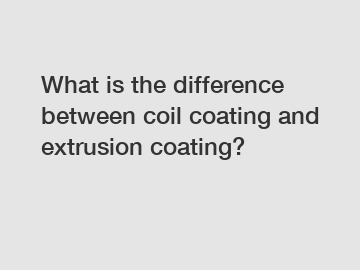What is the difference between coil coating and extrusion coating?
What is the difference between coil coating and extrusion coating?
When it comes to coating materials, two popular methods are often used in various industries: coil coating and extrusion coating. These techniques play a vital role in improving the durability and appearance of products such as metal sheets, packaging materials, and building materials. While they may seem similar at first glance, there are significant differences between coil coating and extrusion coating. In this article, we will delve into these differences and explore the unique characteristics of each method.
1. Process:

Coil coating involves applying a protective coating to a continuous metal coil using a roll coating process. This method usually takes place before the metal is formed into specific shapes or products. The continuous coil is unwound and passes through various stages, including cleaning, chemical treatment, primer application, topcoat application, and curing. Once the coil is coated, it is typically wound back into a coil or cut into sheets, ready for further processing.
On the other hand, extrusion coating is a process where a molten polymer is extruded through a die onto a substrate, forming a continuous protective layer. Unlike coil coating, extrusion coating is commonly used on non-metallic materials such as paper, cardboard, and plastic films. The substrate is fed continuously through the extrusion coating equipment while the polymer is melted and extruded onto its surface. The coated substrate is then cooled, solidified, and wound into rolls or cut into final shapes.
2. Coating Materials:
Coil coating primarily uses liquid coatings, which are specifically formulated to provide excellent adhesion, corrosion resistance, and aesthetic appeal. These liquid coatings consist of various components such as resins, pigments, solvents, and additives. The coil coating process allows for precise and controlled application of these coatings, ensuring uniformity and coverage across the entire coil surface.
In contrast, extrusion coating commonly employs thermoplastic resins, which are melted and extruded onto the substrate. The most commonly used resins in extrusion coating include polyethylene, polypropylene, and ethylene vinyl acetate (EVA). These resins offer excellent barrier properties, flexibility, and heat resistance, making them suitable for a wide range of applications. Additionally, extrusion coating allows for the use of multiple layers if desired, enabling the creation of complex structures and functionalities.
3. Applications:
Coil coating finds widespread application in industries such as construction, automotive, and appliance manufacturing. Metal coils coated through this method are subsequently used for roofing, cladding, garage doors, and even domestic appliances like refrigerators and ovens. The controlled coating process ensures consistent quality and appearance, making coil-coated products highly durable and aesthetically pleasing.
On the other hand, extrusion coating is commonly used in the production of flexible packaging materials, such as laminated films, snack food wrappers, and beverage cartons. The molten polymer creates a protective barrier, preventing moisture, gases, or light from penetrating the package. The versatility of extrusion coating allows for customization of barrier properties, thickness, and appearance to meet specific packaging requirements.
4. Equipment and Production Efficiency:
Coil coating typically involves large-scale, high-speed production lines to accommodate the continuous coating process. The equipment required includes unwinding and rewinding machines, cleaning and pre-treatment systems, coating applicators, curing ovens, and cooling systems. The high level of automation in coil coating ensures efficient and consistent production, leading to cost savings and enhanced productivity.
Extrusion coating, on the other hand, requires extruders, dies, chill rolls, and winding systems. This method offers greater flexibility in terms of coating width and thickness variations, providing manufacturers with more options for customization. However, the production speed of extrusion coating is generally slower than coil coating, making it more suitable for specialized or smaller-scale applications.
In conclusion, while coil coating and extrusion coating are both valuable processes for applying protective coatings to materials, they differ significantly in terms of the process, coating materials, applications, and equipment used. Coil coating predominantly focuses on coating metal coils before they are formed into various products, utilizing liquid coatings for uniform and aesthetically appealing results. On the other hand, extrusion coating is commonly used on non-metallic substrates, employing molten thermoplastic resins to create a protective layer and is often utilized in the production of flexible packaging materials. Understanding these differences allows manufacturers to choose the most suitable coating method for their specific needs.
For more information, please visit painted aluminium coils, prepainted aluminium coil, benefits of coating aluminium coils.

Comments
0